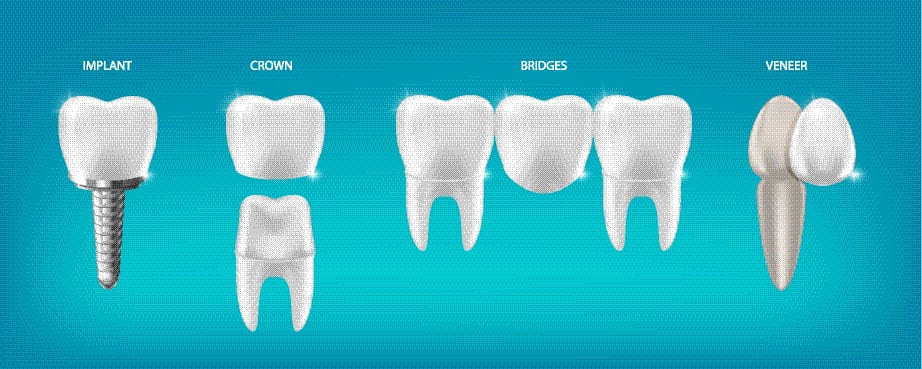Exploring the Options of Tooth Replacement and Restoration
If noticeable dental problems have caused you to join the Closed-Mouth Smile Club, you can take heart in knowing that you’re far from alone.
Many people suffer embarrassing tooth damage such as discolored teeth, chipped teeth, decayed teeth, crooked teeth, and missing teeth.
But your tooth woes don’t have to be a permanent problem.
At Hancock and Johnson Dentistry, we have several tooth restoration techniques to choose from, and we’ll come up with the perfect solution to your unique situation. Now that’s something to smile about!
Crowns/Bridges
Crown and bridge treatment is a permanent method of replacing missing teeth or small teeth.
Crowns are placed on individual teeth that are too damaged for a filling. They could be needed as a result of cavities and tooth decay, or due to peg teeth (meaning teeth that are too small for adult mouths).
Likewise, a bridge spans a space where one or more teeth are missing. The teeth on either end of the span are crowned.
Crowns are about 2 mm in thickness and can be all porcelain or all-metal alloy or a mixture of both. Typically, porcelain crowns are used for visible teeth because they have the most lifelike appearance.
HOW IT WORKS
- We will make an impression of your tooth. This mold will be used to create a crown.
- Next, we will place a temporary crown on your ground-down tooth so you can use it while the permanent crown is being made.
- When the permanent crown is ready, we will remove the temporary crown and cement the permanent crown into place.
IS THIS PROCEDURE RIGHT FOR ME?
| Pros | Cons |
|
|
Source: Healthline
Overall, crowns are best if your tooth has a large filling, a root canal or is very cracked. Bridges are a solid option for filling in the gap of a missing tooth so the neighboring teeth do not shift.
Veneers
Veneers are made of thin 1-mm porcelain shells that fit over your teeth to provide a natural look. They are helpful in fixing chipped, stained, worn-down, uneven, or abnormally spaced teeth.
At Hancock and Johnston, we prefer veneers because they provide the best smile and are easier to customize to your mouth. We fit the exact shape of your teeth through a series of painless in-office visits.
Upper veneers are the most popular option, but our practice can apply veneers to as little as one tooth or as much as a full veneer crown.
HOW IT WORKS
- We carefully examine your teeth and determine the correct color shade for the veneer.
- We then remove a tiny amount of tooth enamel (typically 0.5 mm to 0.7 mm) to provide room to place the veneer on the tooth.
- We then take an impression to create an exact replica of your teeth, which is used to create your custom-made porcelain veneer.
- Temporary veneers may or may not be placed depending on the amount of tooth structure removed.
- During the second visit, we remove any temporary veneers and then evaluate the porcelain veneer fit. You check the shape and color, fit and feel of the veneers before they are bonded to your teeth.
- We clean your teeth with pumice and water or a mild acidic solution. We then bond the veneers with a special adhesive and harden with an ultraviolet lamp.
IS THIS PROCEDURE RIGHT FOR ME?
| Pros | Cons |
|
|
Source: Healthline
Overall, veneers are best if you are an adult whose teeth are basically intact, and the restoration is for cosmetic purposes.
Bonding
Bonding uses a composite resin that is color-matched to your teeth to correct dental problems. Bonding is safe on children and adults, and as such is one of the most common cosmetic treatments.
The procedure comes in handy to treat badly fractured or chipped teeth, cavities, small teeth, stained teeth, and widely spaced teeth.
HOW IT WORKS
- We apply a mild etching solution to the enamel of the tooth, which makes it rough enough to bond with the resin (a liquid plastic), which we then paint on the tooth.
- We then apply a composite resin or bond acrylic to the teeth and shape it.
- After the composite resin has been shaped, we harden it by ultraviolet light exposure before polishing the hardened surface.
IS THIS PROCEDURE RIGHT FOR ME?
| Pros | Cons |
|
|
Source: Healthline
Overall, bonding is best as a cost-effective fix for a single traumatized front tooth. Also, it may be the best option for children because bonding is noninvasive and doesn’t permanently affect healthy teeth.
Implants
Implants give you the ability to replace a missing tooth in a simple in-office surgery. After installing a titanium anchor (shaped like a small screw) into your jaw, you wait for the bone to heal for up to 6 months, at which point a crown is placed over the implant.
This procedure is typically used to replace missing teeth and anchor dentures.
HOW IT WORKS
- Initial surgery includes cutting your gum to expose the jawbone, at which point we will implant the endosteal post into the bone.
- Your jawbone will grow into the implant (called osseointegration). After 2 to 6 months, the implant will be ready for your artificial tooth.
- Finally, we attach the crown to your implant.
IS THIS PROCEDURE RIGHT FOR ME?
| Pros | Cons |
|
|
Source:Healthline, Dentistry.com
Overall, implants are best for adults who are missing a tooth or teeth, who have full-grown jawbones and healthy oral tissue and are willing to commit to the several-month process.
A Final Word…
Throughout your tooth restoration and replacement, you may have questions or concerns. We will make every effort to minimize pain and provide peace of mind during your treatment. And we’re happy to answer any questions you may have. Our goal at Hancock and Johnston Dentistry is to help preserve your smile for a lifetime.

